Stromatolites
The earliest microfossils and living 'fossils'.
Stromatolites videos
Hamelin Pool:
From UNSW:


From UNSW:
Labels: Australia, Hamelin Pool, Shark Bay, stromatolite structure, stromatolites
| 0 Guide-GlossaryModern stromatolites – living fossils
Originating over 3 billion years ago, stromatolites are the oldest known fossils (timeline). Fossilized stromatolites were laid down as colonial structures built by photosynthesizing Cyanobacteria and other microbes. The Cyanobacteria, also called blue-green algae, were responsible for the creation of earth's oxygen atmosphere. These organisms are prokaryotic – cells lacking a cellular nucleus – and thrived in warm aquatic environments, building reefs much as coral does today. Domed columns are typical, and the fossilized structures were quite extensive. Cyanobacteria were the dominant lifeform on Earth for over 2 billion years.
Today stromatolites are nearly extinct, living a precarious existence in only a few localities worldwide – the most famous location is Shark Bay in Western Australia.
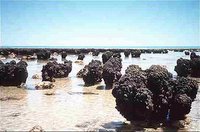 Stromatolites in Shark Bay,
Stromatolites in Shark Bay,  Western Australia – exposed (left) and submerged (right).
Western Australia – exposed (left) and submerged (right).
“At Hamelin Pool in the south of the bay, living microbes still building stromatolites are similar to the earliest life forms which dominated the earth for 3000 million years. Hamelin Pool contains the most diverse and abundant examples of stromatolite forms in the world.” [mod. S]
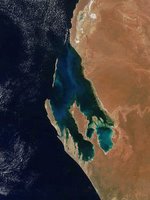 Hamelin Pool is at the southern end of Shark Bay, Western Australia.
Hamelin Pool is at the southern end of Shark Bay, Western Australia.
Low resolution Satellite image of Shark Bay phytoplankton bloom
Full resolution Satellite image of Shark Bay phytoplankton bloom
The extensive Hamelin Pool turf of relict organisms was discovered in 1956. More stromatolites grow in other locations on the ancient shield of western Australia - in the saline Lake Thetis, near Cervantes; in hypersaline lakes on Rottnest Island; in the freshwater Lake Richmond, at Rockingham; and the brackish Lake Clifton, near Mandurah. The link between all Western Australian microbial structures, regardless of the salinity of the water in which they grow, is the presence of calcium carbonate. The source of the calcium carbonate may be groundwater that has passed through lime-rich substrates [Shark Bay Cyanobacteria and Stromatolites]. Map. Western Australia also boasts some of the oldest known examples of stromatolites (3.45 billion years old), occurring as fossils in the Pilbara region between Marble Bar and Port Hedland. Marble Bar stratigraphy stratigraphy-timeline WA microfossils.
More recently, stromatolite colonies have been discovered in locations such as the Bahamas, the Indian Ocean, Yellowstone National Park, and Poza Azul lake at Cuatro Cienegas, Mexico.
______________________________________________
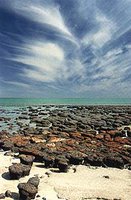 The Hamelin Pool stromatolites in Shark Bay -
The Hamelin Pool stromatolites in Shark Bay - 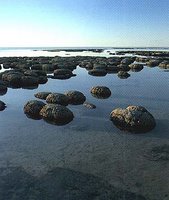 at low (left) and higher tides (right).
at low (left) and higher tides (right).
The water of Hamelin Pool within Shark Bay is twice as saline as typical sea-water because of rapid evaporation from the shallow water, and because a bar across the bay's entrance reduces mixing with normal brine. This hypersaline water is inhospitable to marine browsers, which which otherwise would feed on the bacteria that construct stromatolites. As a result stromatolites can grow undisturbed in Shark Bay. Most stromatolites are extremely slow growing. Those in Hamelin Pool grow at a maximum of .3mm a year. This means that those that are up to a metre high are several thousands of years old.
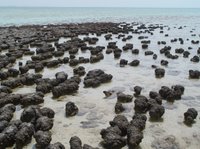
More images of stromatolites of Hamelin Pool (Shark Bay) / stromatolites displaying weathering / partly submerged / partly exposed

Today stromatolites are nearly extinct, living a precarious existence in only a few localities worldwide – the most famous location is Shark Bay in Western Australia.
 Stromatolites in Shark Bay,
Stromatolites in Shark Bay,  Western Australia – exposed (left) and submerged (right).
Western Australia – exposed (left) and submerged (right).“At Hamelin Pool in the south of the bay, living microbes still building stromatolites are similar to the earliest life forms which dominated the earth for 3000 million years. Hamelin Pool contains the most diverse and abundant examples of stromatolite forms in the world.” [mod. S]
 Hamelin Pool is at the southern end of Shark Bay, Western Australia.
Hamelin Pool is at the southern end of Shark Bay, Western Australia.Low resolution Satellite image of Shark Bay phytoplankton bloom
Full resolution Satellite image of Shark Bay phytoplankton bloom
The extensive Hamelin Pool turf of relict organisms was discovered in 1956. More stromatolites grow in other locations on the ancient shield of western Australia - in the saline Lake Thetis, near Cervantes; in hypersaline lakes on Rottnest Island; in the freshwater Lake Richmond, at Rockingham; and the brackish Lake Clifton, near Mandurah. The link between all Western Australian microbial structures, regardless of the salinity of the water in which they grow, is the presence of calcium carbonate. The source of the calcium carbonate may be groundwater that has passed through lime-rich substrates [Shark Bay Cyanobacteria and Stromatolites]. Map. Western Australia also boasts some of the oldest known examples of stromatolites (3.45 billion years old), occurring as fossils in the Pilbara region between Marble Bar and Port Hedland. Marble Bar stratigraphy stratigraphy-timeline WA microfossils.
More recently, stromatolite colonies have been discovered in locations such as the Bahamas, the Indian Ocean, Yellowstone National Park, and Poza Azul lake at Cuatro Cienegas, Mexico.
______________________________________________
 The Hamelin Pool stromatolites in Shark Bay -
The Hamelin Pool stromatolites in Shark Bay -  at low (left) and higher tides (right).
at low (left) and higher tides (right). The water of Hamelin Pool within Shark Bay is twice as saline as typical sea-water because of rapid evaporation from the shallow water, and because a bar across the bay's entrance reduces mixing with normal brine. This hypersaline water is inhospitable to marine browsers, which which otherwise would feed on the bacteria that construct stromatolites. As a result stromatolites can grow undisturbed in Shark Bay. Most stromatolites are extremely slow growing. Those in Hamelin Pool grow at a maximum of .3mm a year. This means that those that are up to a metre high are several thousands of years old.

More images of stromatolites of Hamelin Pool (Shark Bay) / stromatolites displaying weathering / partly submerged / partly exposed
Labels: colonies, Cyanobacteria, fossilized stromatolites, Hamelin Pool, Shark Bay, stromatolites
| 0 Guide-GlossaryCyanobacteria and stromatolites
The Cyanobacteria comprise only one clade of photosynthetic bacteria. The Cyanobacteria differ from other clades of photosynthetic bacteria in that they utilize both photosystems I and II. Cyanobacteria perform oxygenic photosynthesis through photosystem II, so they evolve oxygen, and are generally believed responsible for the rise in atmospheric oxygen that followed their emergence at least 3450 million years ago.
The ability of Cyanobacteria renders them ecologically important both as primary producers and for their ability to fix nitrogen.
Cyanobacteria process only chlorophyll a. Their accessory pigments include carotenoids, but the presence of the phycobilins (phycoerythrin and phycocyanin) are a feature of the group. Cyanobacteria undoubtedly gave rise to the chloroplasts of eukaryotic cells through the process of endosymbiosis.
Several of the Cyanobacteria show a striking resemblance to fossil counterparts [im, image links]. It has been suggested that "exchange of genetic material for neutrally evolving genes may explain the apparent stability of cyanobacterial morphological characters, perhaps over billions of years." [R]

Two alternative views on the relationship of the major lineages (omitting viruses) of Life on Earth (left). Modern extremophiles are considered closely related to the Archaea.
Genome analysis has provided some clarification, but horizontal gene transfer between prokaryotes blurs evolutionary relationships.

The ability of Cyanobacteria renders them ecologically important both as primary producers and for their ability to fix nitrogen.
Cyanobacteria process only chlorophyll a. Their accessory pigments include carotenoids, but the presence of the phycobilins (phycoerythrin and phycocyanin) are a feature of the group. Cyanobacteria undoubtedly gave rise to the chloroplasts of eukaryotic cells through the process of endosymbiosis.
Several of the Cyanobacteria show a striking resemblance to fossil counterparts [im, image links]. It has been suggested that "exchange of genetic material for neutrally evolving genes may explain the apparent stability of cyanobacterial morphological characters, perhaps over billions of years." [R]

Two alternative views on the relationship of the major lineages (omitting viruses) of Life on Earth (left). Modern extremophiles are considered closely related to the Archaea.
Genome analysis has provided some clarification, but horizontal gene transfer between prokaryotes blurs evolutionary relationships.
Labels: Archaea Tree, Cyanobacteria, Eocyte Tree, fossils, oxygenic photosynthesis, pigments, stromatolites
| 0 Guide-GlossaryStromatolite structure
Stromatolites grow slowly – layer upon layer – as mats of Cyanobacteria grow atop older layers. Because this process still occurs today,  scientists were able to determine the origin of carbonaceous material in fossilized laminated domes found widely around the globe.
scientists were able to determine the origin of carbonaceous material in fossilized laminated domes found widely around the globe.
Bacterial photosynthesis depletes carbon dioxide in the surrounding water, initiating precipitation of calcium carbonate. Layers of CaCO3 precipitate over the growing mat of bacterial filaments. This mineral, together with grains of sediment precipitating from the water, is trapped within a sticky layer of mucilage that surrounds the bacterial colonies. The cyanobacteria continued to grow upwards through this sediment to form a new layer. As this process occurs over and over again, layers of sediment are created.
Hamelin Pool in Shark Bay in western Australia is well known for the stromatolite "turfs" rising along its beaches. Meter-high stromatolites in the northern Bahamas are alternately buried and exhumed by carbonate sand bodies in an area of active bedform migration. Marooned Mexican stromatolites in Poza Azul lake at Cuatro Cienegas, Mexico, are of interest to NASA scientists who believe that these calcified clumps of primitive bacteria lurking in cactus-ringed lagoons could provide important clues in their search for extraterrestrial life.
Images: diagram of stromatolites in dolomite block / fossil showing columnar structure / cylindrical structure / fossil showing striations / diagram of stromatolite morphology / stromatolite types /

 scientists were able to determine the origin of carbonaceous material in fossilized laminated domes found widely around the globe.
scientists were able to determine the origin of carbonaceous material in fossilized laminated domes found widely around the globe.Bacterial photosynthesis depletes carbon dioxide in the surrounding water, initiating precipitation of calcium carbonate. Layers of CaCO3 precipitate over the growing mat of bacterial filaments. This mineral, together with grains of sediment precipitating from the water, is trapped within a sticky layer of mucilage that surrounds the bacterial colonies. The cyanobacteria continued to grow upwards through this sediment to form a new layer. As this process occurs over and over again, layers of sediment are created.
Hamelin Pool in Shark Bay in western Australia is well known for the stromatolite "turfs" rising along its beaches. Meter-high stromatolites in the northern Bahamas are alternately buried and exhumed by carbonate sand bodies in an area of active bedform migration. Marooned Mexican stromatolites in Poza Azul lake at Cuatro Cienegas, Mexico, are of interest to NASA scientists who believe that these calcified clumps of primitive bacteria lurking in cactus-ringed lagoons could provide important clues in their search for extraterrestrial life.
Images: diagram of stromatolites in dolomite block / fossil showing columnar structure / cylindrical structure / fossil showing striations / diagram of stromatolite morphology / stromatolite types /
Labels: Cyanobacteria, Hamelin Pool, Shark Bay, stromatolite structure
| 0 Guide-GlossaryAncient stromatolite reefs
 Northern Canada possesses some of the best preserved examples of Proterozoic reefs and other carbonates anywhere in the world .[Precambrian pinnacle reef, NWT ]
Northern Canada possesses some of the best preserved examples of Proterozoic reefs and other carbonates anywhere in the world .[Precambrian pinnacle reef, NWT ]Ancient fossilized strata of stomatolites at Steep Rock Iron Mine Steep Rock Stromatolites, Canada (right). The Canadian shield boasts one of the earth's oldest known rock formations [Acasta Gneisses] and three of the world's earliest known Archaean stromatolite formations: Steep Rock Lake and Red Lake in Ontario, and Yellowknife in the Northwest Territories.
Originating over 3 billion years ago, stromatolites are the oldest known fossils. Fossilized stromatolites were laid down by colonial structures built by photosynthetic Cyanobacteria and associated microbes. The Cyanobacteria, also called 'blue-green algae', were responsible for the creation of earth's oxygen atmosphere. These organisms are prokaryotic – cells lacking a cellular nucleus – and thrived in warm aquatic environments, building reefs much as coral does today. Domed columns are typical, and the fossilized structures were quite extensive. Cyanobacteria were the dominant lifeform on Earth for over 2 billion years.
Today stromatolites are nearly extinct, living a precarious existence in only a few localities worldwide – the most famous location is Shark Bay in Western Australia. _______________________________________________________________________
 Precambrian stromatolites of the 1.3 Ga Siyeh Formation in Glacier National Park (left)
Precambrian stromatolites of the 1.3 Ga Siyeh Formation in Glacier National Park (left)"The centres of many stromatolites in the Siyeh Formation are concave downward rather than domed upward, as if they have collapsed. This may, indeed, have happened. The region lay close to the edge of the continent, where frequent earthquakes would have shaken the stromatolites, perhaps damaging them in this way." Source
NW Ontario, Canada contains the Archean Steep Rock carbonate platform, noted as one of the best-exposed and preserved platforms of this age on the planet: Archaean Carbonate Platform stromatolite reef / Archaean stromatolite reef
Stromatolite in ferruginous chert-carbonate unit, Kakabeka Falls
 Carbonate Chert Picture.
Carbonate Chert Picture.Note that the stamp contains an error. What is it?
More images of fossilized stromatolite reefs: Gunflint formation stromatolites on Canadian shore of Lake Superior / exhumed stromatolites 1.8 Ga near Great Slave Lake, Canada / close-up of Great Slave Lake stromatolites / Siyeh Formation in Glacier National Park / bioherm of intertidal columnar stromatolites / domal stromatolites / Petrified Springs Reef near Saratoga Springs / Petrified Springs "Lion" / Lykins Formation / Table Head Group, Nfld, Canada / Ordovician St. George Group, Nfld / patch reef Middle Cambrian, Nfld / Durness Group, Scotland / Johnnie formation, California, 65 Ma / stromatolite reef Auvergne, France and close up of fossilized stromatolite / fossilized stromatolite reef in Mungok Ri, Korea / close-up of a reef
Labels: Cyanobacteria, oxygenic photosynthesis, reefs, Shark Bay, stromatolites
| 0 Guide-Glossary







































